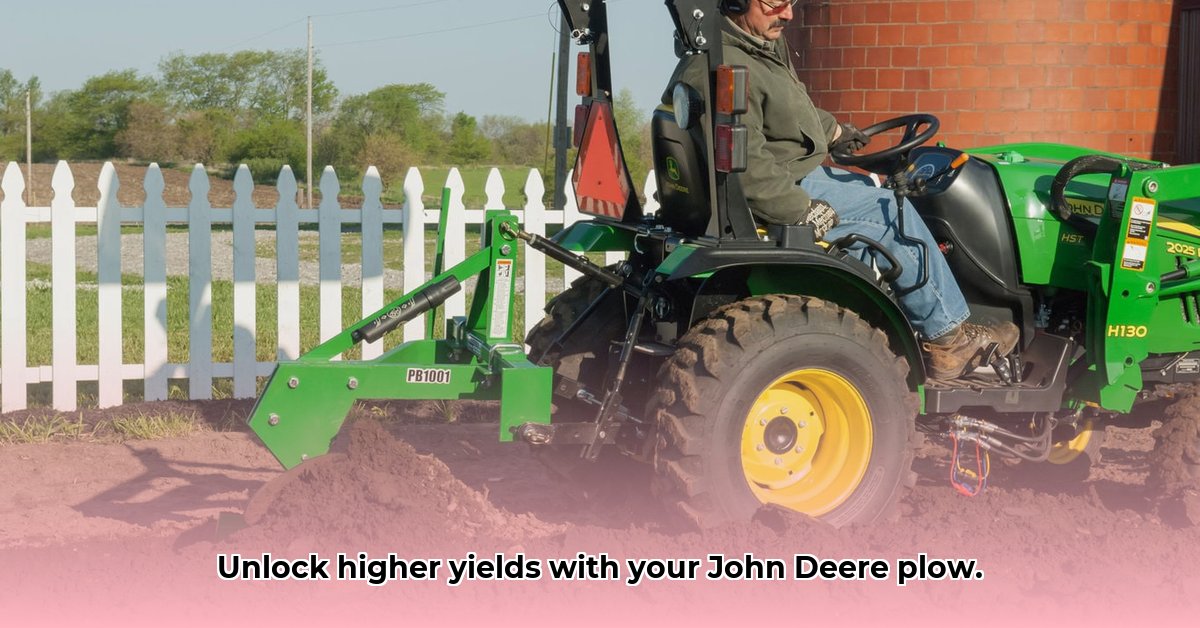
Choosing the Right Plow for Your John Deere Tractor
Selecting the appropriate plow for your John Deere tractor is crucial for maximizing yield and efficiency. The ideal plow will depend on several factors, ensuring optimal soil preparation for planting and overall farm productivity. Ignoring these factors can lead to reduced yields and increased equipment wear. For more information on John Deere tractor blades, check out this helpful resource: John Deere Blades.
Understanding Your Soil Type and Farming Objectives
Before selecting a plow, a thorough assessment of your soil type is essential. Different soil types, such as heavy clay, sandy loam, or loamy soil, require different plowing techniques and equipment. Clay soils, for instance, demand robust plows capable of handling their resistance. Knowing the characteristics of your soil will guide you toward the best-suited plow type and size. Furthermore, your farming objectives—whether weed control, seedbed preparation, or erosion control—will significantly influence your choice.
Exploring Plow Options: Moldboard, Disc, and Chisel Plows
Several plow types are compatible with John Deere tractors, each with distinct advantages and disadvantages.
Moldboard Plows: These traditional plows completely invert the soil, burying weeds and creating a fine seedbed. While excellent for heavy clay soils and providing superior weed control, they consume considerable fuel and require powerful tractors.
Disc Plows: Offering greater versatility, disc plows cut and slice through the soil, making them suitable for rocky or residue-heavy fields. They require less horsepower compared to moldboard plows but provide less soil inversion and weed control.
Chisel Plows: Ideal for deep tillage of compacted soil, chisel plows break up hardpan layers without inverting the soil. This improves drainage and aeration but offers limited weed control. They are less fuel-intensive than moldboard plows.
Other specialized plows, like subsoilers and rotary tillers, cater to specific needs. Thorough research will pinpoint the best choice for your farm.
Matching Plow Size to Tractor Power: A Crucial Consideration
Choosing the right plow size is critical to avoid overloading your tractor or underutilizing its capacity. Consider your tractor's horsepower, field width, and soil type. Consult your John Deere manual or a dealer for recommended plow sizes. Many experts advise choosing a slightly smaller plow than the maximum your tractor can handle to accommodate soil variations and ensure consistent performance. Don't underestimate the impact of proper sizing – it can significantly affect fuel efficiency and longevity.
Installing and Maintaining Your Plow: A Step-by-Step Guide
Proper installation and maintenance are key to maximizing plow lifespan and efficiency. These procedures should always be followed precisely.
- Consult Manuals: Always refer to your tractor's and plow's instruction manuals. This step is critical for correct setup.
- Hitch Alignment: Carefully align the hitch points and ensure secure fastening.
- Lubrication: Regularly lubricate moving parts to maintain smooth operation.
- Inspection: Periodically inspect for wear and tear: loose bolts, cracks, or excessive wear on plowshares.
- Component Replacement: Promptly replace worn components to prevent further damage.
Following these steps will significantly improve plow performance and extend its operational life. Proactive maintenance is far more cost-effective than reactive repairs.
Troubleshooting Common Plow Issues
Even with careful maintenance, occasional issues may arise. These troubleshooting steps provide a practical approach to resolving common problems.
- Obstruction Removal: Check for rocks, soil clumps, or plant debris obstructing the plow.
- Depth Adjustment: Verify depth settings are appropriate for your soil type and task.
- Hitch Adjustment: Ensure the tractor's hitch is correctly adjusted.
- Professional Assistance: If problems persist, consult your John Deere manual or a qualified mechanic.
Promptly addressing these issues will prevent minor problems from escalating into costly repairs.
Plow Type Comparison: A Summary of Pros and Cons
The following table summarizes the key advantages and disadvantages of different plow types:
| Plow Type | Pros | Cons |
|---|---|---|
| Moldboard Plow | Excellent soil inversion, superior weed control, creates fine seedbed | High fuel consumption, requires more horsepower, less suitable for stony soils |
| Disc Plow | Handles heavy residue and stony soils well, requires less horsepower | Less soil inversion, can be noisy, may not provide as effective weed control |
| Chisel Plow | Deep tillage, improves drainage and aeration, less fuel intensive | Doesn't invert soil, may not effectively control weeds, not suitable for all soil types |
Remember, the choice depends on your individual farm needs and soil conditions.
Key Takeaways:
- Soil type and farming objectives significantly influence plow selection.
- Different plows (moldboard, disc, chisel) offer unique advantages and disadvantages.
- Proper installation, maintenance, and troubleshooting are crucial for optimal performance.
This comprehensive guide empowers you to confidently choose and maintain the right plow for your John Deere tractor, leading to increased yields and efficient farming practices.